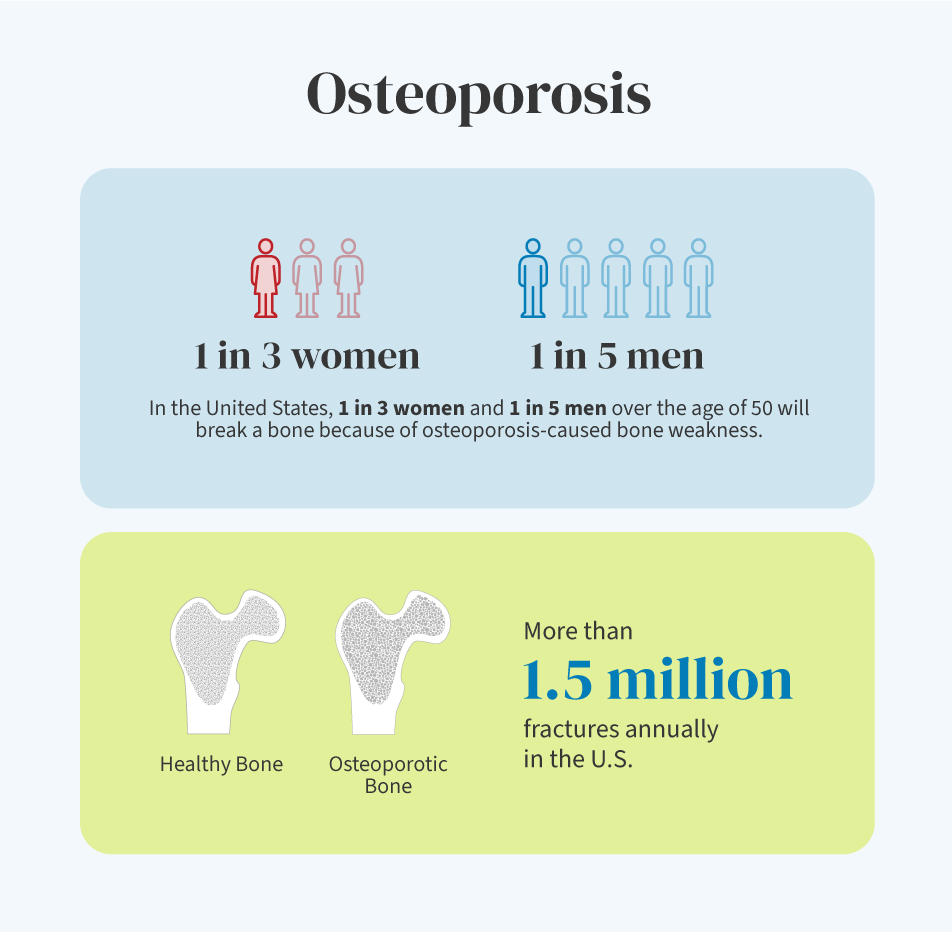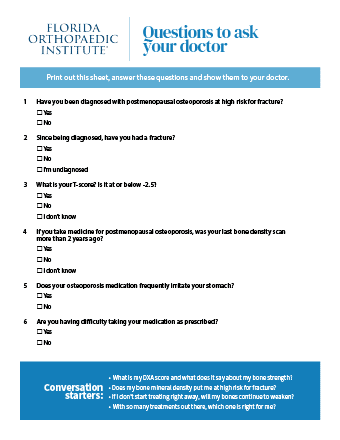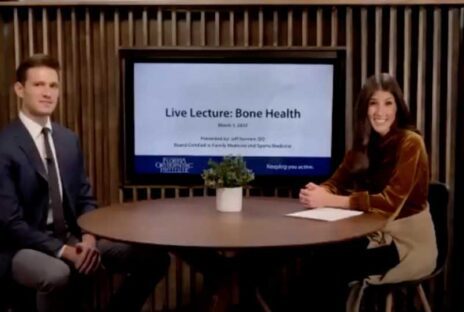Osteoporosis treatment
Expert osteoporosis care from orthopedic physicians
Osteoporosis is a disease of the bones that causes them to break down over time, making you more likely to have a fracture injury. It’s caused by a variety of things, like normal aging, gender, smoking, drinking, lifestyle changes, taking drugs, certain illnesses, and having a broken bone. It can be serious if left undiagnosed or untreated. There’s no cure for it once you know it’s there, but there are treatments that can help make your bones stronger and less likely to break.
Preventive care plays a significant role in your health and overall well-being. Given the risk factors for osteoporosis and your history of fracture, you may be at elevated risk for another fracture. Osteoporosis is sometimes called the “silent disease” because many do not know or assume they do not have it until they suffer a fracture.

Learn more about
Common osteoporosis conditions
Our orthopedic physicians are experts at identifying and understanding the risk factors and complications of osteoporosis, including:
- Humeral Fractures
- Hip Fractures
- Pelvic Ring Fractures
- Spinal Compression Fractures
- Ankle Fractures
- Wrist Fractures
- Rib Fractures
- Spinal Deformity (Dowager’s Hump)


Download and complete the bone health intake form to help your physician develop your personalized osteoporosis treatment plan.
Bone Health Intake Form (Women)
Bone Health Intake Form (Men)
“I had a flawlessly perfect experience at FOI - Telecom Park!!! I was in extreme pain and distress, and the entire staff from the front desk to the team of staff working in Zone 2 and X-ray worked quickly and proficiently to get me in, taken care of, and on my way home!” Patient | Bone Health Clinic
Osteoporosis treatment from the Bone Health Clinic
The Bone Health Clinic at Florida Orthopaedic Institute can help manage your recovery and prevent future injury through screening, diagnosis, treatment, therapy and education. Osteoporosis doesn’t have to stop you from enjoying your life. Optimize prevention and reduce your risk by making an appointment today.
There are many benefits of exercise and physical activity for bone health. Regular exercise increases muscle strength and tone, which will also lead to strengthening bones. Exercise improves balance and coordination, leading to decreased risk for falls. Exercise can also improve your posture and flexibility, lessen pain, and increase your stamina for daily activities. It is important to find a safe form of exercise that you enjoy based on your individual health and needs. Consult with your doctor to determine the right kinds of exercise based on your physical fitness, health, and bone density.
The most common forms of exercise that are beneficial for bone health include weight bearing exercises, such as walking or running. Strength training exercises and weightlifting strengthens skeletal muscle and bones, improving strength and stamina. Balance and flexibility exercise reduce the risk for falls by improving coordination and gait. Choosing the right exercises for you can be challenging, your physician at FOI may refer you to a physical therapist to learn these exercises in a supervised program to improve your overall health.
Supplementation with vitamin D3 and calcium is important to maintaining healthy bone metabolism. Vitamin D is important for regulating calcium metabolism in the body. Deficiency in vitamin D is common throughout the world due to lack of dietary intake, intestinal malabsorption, or decreased sun exposure. Deficiency in vitamin D will lead to poor absorption and metabolism of calcium in the body, which contributes to decreased bone density. Patients diagnosed with osteopenia or osteoporosis should take vitamin D3 and calcium daily. The optimum amount of vitamin D and calcium is not the same for everyone, your physician will help you determine the amount that you should be taking.
The most severe complication of low bone density is having a fracture. Depending on personal medical history and a bone density measurement, future fracture risk can be calculated to determine the need for prescription therapy. If you have already had a fracture or multiple fractures, you will benefit from prescription therapy to reduce the risk of further fractures. There are several different prescription therapies available that slow the loss of bone and improve the strength of bone. These therapies are available as oral medications (tablet/capsule), intravenous medications, or subcutaneous injections. At FOI your physician will determine if you need prescription therapy based on your fracture risk and then will help you determine the right type of therapy.
Related specialties
- Anterior Hip Replacement
- Avascular Necrosis (Osteonecrosis)
- Groin Strains & Pulls
- Hamstring Injuries
- Hip Arthroplasty
- Hip Arthroscopy
- Hip Dislocation
- Hip Flexor Strains
- Hip Fractures
- Hip Hemiarthroplasty
- Hip Impingement Labral Tears
- Hip Muscle Strains
- Hip Pointers & Trochanteric Bursitis
- Iliopsoas Tenotomy
- Labral Tears of the Hip (Acetabular Labrum Tears)
- Osteoarthritis of the Hip
- Pelvic Ring Fractures
- Piriformis Syndrome
- Sports Hernias (Athletic Pubalgia)
- Thigh Fractures
- Thigh Muscle Strains

